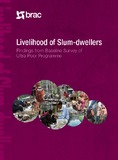Livelihood of slum-dwellers: Findings from baseline survey of ultra-poor program
Citation
Jimi, N. A., Rahman, A., Ahmad, S., Ara, J., & Bhattacharjee, A. (2016). Livelihood of slum-dwellers: Findings from baseline survey of ultra-poor program. Dhaka, Bangladesh: BRAC Research and Evaluation Division. Retrieved from https://bigd.bracu.ac.bd/wp-content/uploads/2020/03/Livelihood-of-Slum-dwellers-Findings-from-Baseline-Survey-of-Ultra-Poor-Program.pdfAbstract
The groundbreaking program of BRAC titled “Challenging the Frontiers of Poverty Reduction-Targeting the Ultra Poor (CFPR-TUP)” commenced in 2002 with the intention to meet the challenge to reach and help the ultra-poor. The main purpose of this report is to have a thorough documentation and understanding of the profiles of the ultra poor population covered by the Urban CFPR-TUP program. For the purpose of comparison of the targeted ultra-poor households with other households and also for assessing spillover effects, information was also collected on non-participant households from the same community. Information on the livelihood indicators of national urban population have been collected from Household Income and Expenditure Survey, 2010 and other relevant national data sources. The report explores numerous findings in great detail. Among others, the average household size for the four groups has been found to range between 3.54 and 4.31, and in terms of issues of food consumption and expenditure, we see that there are no significant differences between STUP and OTUP households regarding food expenditure, food consumption, and calorie and protein intake. On the other hand, the nutritional status of children under 5 years is quite unsatisfactory across all the groups, with high prevalence of stunting, wasting and underweight among the children of the community.

